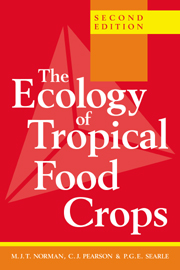7 - Sorghum (Sorghum bicolor)
Published online by Cambridge University Press: 05 June 2012
Summary
Taxonomy
Sorghum is a member of the subfamily Panicoideae, tribe Andropogoneae (Clayton & Renvoize, 1986). Harlan & de Wet (1972) recognise two species only of Sorghum, the diploid S. bicolor (2n = 20), including all cultivated and wild sorghums, and the tetraploid S. halepense (2n = 40), a perennial weed of arable land. Doggett (1988) also recognises a wild diploid species, S. propinquum, and pasture agronomists usually accord specific status to the cultivated forage types sudan grass (S. sudanense) and columbus grass (S. almum).
Doggett (1988) recognises three subspecies of the annual, S. bicolor: bicolor, which is cultivated, drummondii, which is a weed of sorghum in Africa; and verticilliflorum, which is naturalised widely throughout savannas. Harlan & de Wet (1972) divide the cultivated S. bicolor subspecies bicolor into five races:
bicolor: the least specialised, with the widest distribution. Now sporadically cultivated across the African savanna and in south and southeast Asia.
guinea: the dominant race of the West African savanna, India and southeast Asia.
caudatum: important in central tropical Africa.
kafir: the dominant race in Africa south of the equator.
durra: the dominant race in the Near East and parts of India.
Harlan & de Wet also postulate ten ‘intermediate’ cultivated races, being all combinations in pairs of the five basic races. They classify all the wild races as subspecies arundinaceum.
Origin, evolution and dispersal
Although all are agreed that the domestication of sorghum took place in Africa, there is controversy concerning its focus.
- Type
- Chapter
- Information
- The Ecology of Tropical Food Crops , pp. 145 - 163Publisher: Cambridge University PressPrint publication year: 1995
- 1
- Cited by



